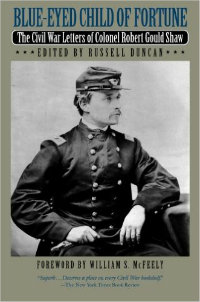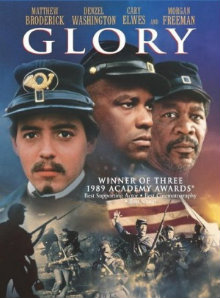Browsing History With a Silent Student Discussion
A MiddleWeb Blog

We see a historical reference in the newspaper and can’t wait to share it with our breakfast table companions – children, partners, dogs, cats. We hear something with a history twist on the radio and it reframes the discussion for us on immigration, abortion, the minimum wage.
At the end of our unit this year on the film Glory in my eighth-grade U.S. history class, I wanted to know what my students found interesting.
And so we replicated in our classroom the adult experience of “browsing history.” The eighth graders would find their own “telling moments,” and then their classmates would read and comment on them in a silent discussion, in a Google Doc, for most of a class period.
The results, in my second year of doing this project, soared beyond my expectations. Even though I would change elements for next time, the student-owned benefits of the activity made it a keeper.
Part 1: Finding the “Money Quote”
First, we spent a day in the library for students to do research. They took five or ten minutes to write at least three questions based on handouts we had studied in our three-week unit thus far, including:
The first chapter of James McPherson’s For Cause and Comrades: Why Men Fought in the Civil War
- Lincoln’s Gettysburg Address and the Emancipation Proclamation
- Textbook readings on women and African-Americans in the war
- Letters that Robert Gould Shaw (Matthew Broderick’s character) wrote to his parents about his evolution as a leader of the 54th Massachusetts Regiment, in Russell Duncan’s Blue-Eyed Child of Fortune
Then students browsed for half an hour – looking through at least three reliable free websites or ProQuest Research Library articles – to find a “money quote” or a “gee whiz statistic.”
An authentic audience was embedded in the assignment. Students knew that whatever quote they found, they would be posting it – along with a catchy title and 75-100 words of commentary about why they chose it – to a Google Doc for the next night’s homework. (Jason took “catchy title” to a new level for his entry about amputation during the Civil War: “How Not to Saw Off a Limb.”)
The quotations and facts ended up being consistently fascinating.
Part 2: The Silent Discussion
A few days after the initial research, students came to the computer lab, excited to begin the silent discussion.
Each student had to comment on three class colleagues’ documents, those following their own last name alphabetically. Rather than using the Google comments feature, for ease of reading students simply typed their comments below the person’s quotation and explanation.

After students finished their three required comments, they could comment on any other students’ work in the 20 to 25 minutes the discussion lasted. The comments had to be specific, positive, and in complete sentences – not just “Awesome!”
And students really engaged with each others’ ideas, in a variety of fonts and colors.
For example, in the third comment on Lauren’s quotation about women as “silent heroines,” one student wrote, “I think it is such a shame that more women didn’t get more appreciation. I agree with Ben and Cole that it shows the determination that these women had for their country and that they were just as tough as the men.”
Part 3: The Aftermath
Unexpectedly, I even enjoyed the grading, as grading goes. Students copied their entire assignment, plus classmates’ comments, from the Google Doc and then pasted it in an email to me. I emailed back a couple of sentences, such as, “This is a wonderful quotation, and you analyze Grant’s actions nicely with the word ‘respectable.’ Watch typos. I think you will enjoy looking at the actual language of surrender next week as we discuss total war!”
Their words and mine coexisted in one place, implying a conversation between colleagues. I felt I was getting inside each of their heads in a relaxed, thoughtful way.
Thoughts about next time

I would also make the discussion longer, maybe 30 to 35 minutes, and encourage more back-and-forth conversations within the comments.
As Ben suggested, “For me it would be better if we had a shorter time to comment, but then additional time to respond to the comments at the end. That way it allows us to go beyond the original line of thinking and think about the issue from another person’s point of view.”
Ultimately, what the students and I got out of this assignment reminded me of the power of curiosity and the appeal of talking to each other online.
The quiet students shone. The talkative students had to share the floor. Ideas burst from the document.
As Cole reflected, “I found that in this discussion, I could go deeper into thought than in a normal discussion.”
And Ellen wrote, “To me, one of the biggest benefits is kids are able to get all of their ideas out.”
This is an assignment that I would want to do. While students were commenting on each others’ ideas, I even felt a little left out.
Perhaps this is a new measure of creating an authentic audience: Making the project so much fun and interactive that we as teachers want to join in!






























What a fantastic lesson plan! Google Slides might help the formatting issue you ran into. I did an assignment with my class in which each student created one slide and then we went through all of them as a class.
Having a silent discussion is brilliant and sounds like it was very successful in eliciting participation from the quieter students. I can’t wait to try it next year!
Laura, thanks so much for the suggestion about Google Slides. I will look into it, and I hope you try the assignment next year.
Love it. Thanks for sharing. If the purpose is to have full student participation and to conduct formative assessment, grading can be simplified.
You might consider this alternative next time:
• Day One – Research
• Day 2 Post chosen information according to assignment guidelines and and give students a couple of days to reply. One organizational pattern that works is to have students sign up in COLOR groups of 5. Research Day 1. Post on Day 2.
• Respond on Days 3 and 4.
This will give you time to “read” their postings and comments without having to grade anything other than on time postings and courteous, thoughtful replies.
• Day Two: On-time posting according to assignment requirements earns full credit. All, incomplete, no posting.
• Day Three and Day Four – On-time post of responses earns full credit.
Consider using INSERT COMMENT option for responses. Then no need to copy and paste to completed document. Days 3 and 4. For example, RED responds to BLUE; BLUE to GREEN; GREEN to ORANGE; ORANGE to PURPLE; and PURPLE to RED..
If you’d like each student to start with fresh first read (not influenced by prior comments), have students download fresh documents for three classmates. Save as GROUP COLOR, WRITER’S NAME and RESPONDER’S name in subject line. I.E., BLUE-COOPER-ROSEBORO
See my adaptation of in-class feedback at this link. http://goo.gl/7fgE5R
Keep up the good work.
Anna, the color-coding organization and spaced-out response time are brilliant strategies! Thanks so much for the suggestions and for the link.